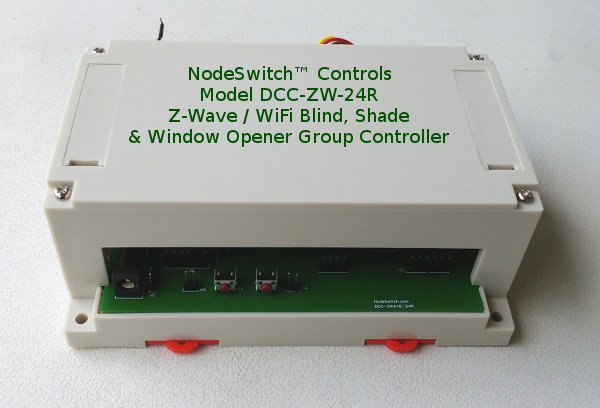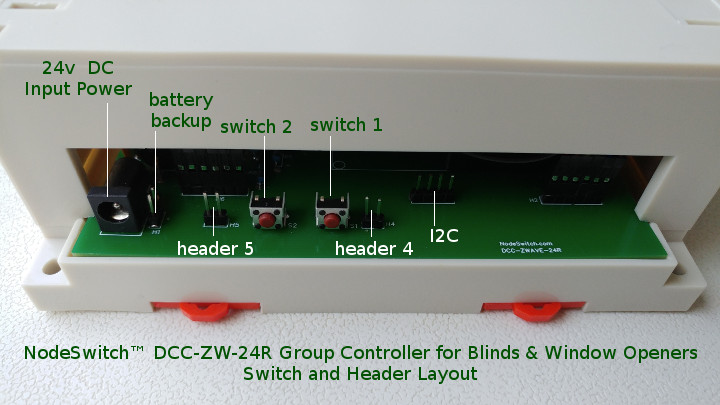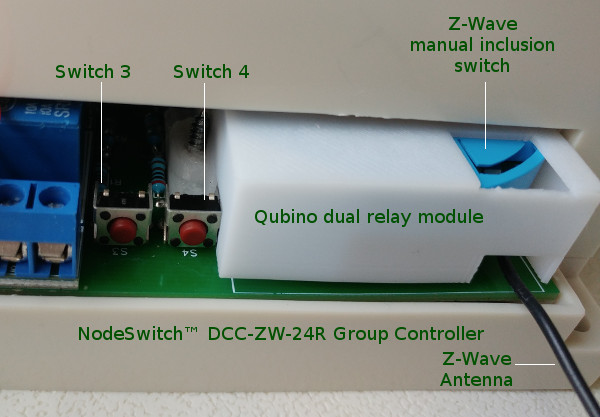Z-Wave & WiFi Group Control: Z-Wave Quick Start Procedure
 As mentioned in Part 1A of this article series, we learned how to clone your radio motors to the group transmitter.
As mentioned in Part 1A of this article series, we learned how to clone your radio motors to the group transmitter.
If you haven't yet assigned your radio motors to the transmitter, please see Part 1A: Cloning Motor Channels that explains how to do this.
The default mode of operation is Z-Wave, and it is set to "auto-include" the Qubino trigger module into your Z-Wave network when power is first applied.
There is a small OLED display built into the microcontroller board that will help with the procedure, if you remove the 4 screws that hold the cover on.
The OLED display has six lines of text that will display appropriate data, depending on what you do. It is set to automatically turn off ater 5 minutes.
Please Note: These instructions assume that you have pre-programmed your motors to work with the internal transmitter. We quite often pre-program the motors and transmitter for clients, but please follow this guide if you need to do this (we will be updating this article soon).
Here is the procedure:
- Plug the 24v DC power supply into the Z-Wave controller, but do not plug the power supply into a wall outlet yet
- Set your hub into "inclusion" mode using the Z-Wave hub app or web interface (1, 2)
- Plug the group controller power supply into the wall outlet to power it up
This should cause the hub to detect the Qubino module and "auto-include" the group controller within 5 seconds; our initial testing with a Vera hub worked immediately. The hub app or interface will respond with screen messages, and you should see two new switches appear. These switches control the 2 relays, which open and close the blinds (or our electric window openers). Here is what it looks like in the Vera web interface:

Testing The Controller with the Built-In Test Switches
There are 4 switches on the controller motherboard that are accessible without removing the cover. Two of them are on one side, and the other two are on the other side.
Switch 1 and Switch 2 are used as test switches for each of the relays in the Qubino dual relay module. If you press Switch 1 (marked as S1 on the motherboard), it should issue an OPEN command to the group transmitter for the blinds (depending on how you have the radio motors programmed). Switch 2 should perform the reverse operation, normally set to CLOSE the blinds. When you release either button, the controller will issue a STOP command to the group transmitter.
There are two important points with regards to the operation:
- The motors will run as long as either of the switches are turned on, until the travel limits of the motor have been reached
- If you try to turn both switches on at the same time, the controller will automatically issue a STOP command
We recommend that you create an automation sequence (called a "scene" on some hubs) whereby your hub turns the relay off after a timed period that permits full excursion. You can also create different automation sequences that open the blinds or window openers partially (eg. 25%, 50%, 75% etc).
This picture shows the location of the test switches and other important headers and connections on the motherboard:

Please Note: The switches are "interactive" in that they will transmit on/off status to your Z-Wave hub interface. If you hold either switch ON, you should see the corresponding virtual switch in your hub interface turn ON too. It may take a second or two for that to happen.
The headers (H4 & H5) on either side of switch 1 and 2 are simply parallel connections to those switches, in case you want to hook up external switches. The I2C header exposes this useful bus so that you can connect an external device, such as an OLED or TFT display.
Switch 3 (opposite side) is used with a long press to invoke the WiFi mode of operation (see Part 3 in this article series). Switch 4 is used to toggle the OLED on and off, but it really isn't necessary as the OLED will time out anyway.Z-Wave Manual Inclusion Procedure
If the auto-inclusion process does not work with your hub, you can also install it manually. Please keep power applied to the Unity controller and make sure your hub is in "inclusion" mode.
Press and hold the service button for longer than 2 seconds, as shown in the picture below (it is a plastic tab that you hold down to make contact - there is no tactile response). This process should cause the Qubino dual relay module to pair with the hub, and the 2 switches should appear in the hub app or interface.
Alternatively, you can press Switch SW1 3 times within 3 seconds (see other side picture above) - this should also cause the Qubino unit to be "included" into the Z-Wave network, and the 2 switches should appear in the hub app or web interface.
If you want to do a factory re-set, hold the service button down for longer than 6 seconds.

A Word About Digital Radio Signal Range
The antenna position affects range profoundly. If you wall mount the controller with the Zwave antenna pointing straight up, you will usually get the best results. We have tested a single installation here with about 60 feet of range with the Zwave hub on one floor and the controller on a second floor, with about 4 rooms in between (typical wood frame/sheetrock home construction).
It is important to understand that the radio signal that is transmitted from the controller to the motor is much more powerful than the Zwave signal - it will reach anywhere in a typical home, so it's ok to put the controller close to the Zwave hub and let the direct motor control signal do the heavy lifting.
Also, keep in mind that most Zwave devices are also 'signal forwarders' (including the Qubino unit in our controller) so adding more devices in your home should improve the Zwave range results.
If you are dealing with a concrete or cinder block structure, please note that your radio signals will not have as much range.
Z-Wave Additional Notes (1, 2)
(1)You may have to choose the Qubino dual relay module (Flush 2 Relay), if it is specifically supported by your hub. If not, you should choose 'generic Z-Wave device' (or something similar, depending on your hub software).
The Qubino dual relay module must be operated in its default mode. There are various additional parameters that can be set for different modes of operation, but changing the mode of operation will cause it to function improperly. All you need to do is "auto-include" it when you first activate the unit.
(2)The SmartThings hub requires the installation of 2 special handlers that support the Qubino dual relay:
- handler1: advanced settings for the Qubino 2 Relay module
- handler2: child device handler for the Qubino 2 Relay module to control 2 channels separately
Please check this link for the Qubino dual relay module instruction manual in PDF format. It is not required reading, but we have included it in case you want to study it further.
Purchase This Unit in Our Online Store
You can purchase our Unity group controller for blinds and window openers, and our other control products in our online DIY automation store.
Adrian Biffen
Senior Partner
NodeSwitch™ Controls
We sincerely hope you enjoy our advanced technology products; if you have any questions, please contact us at any time!
Articles in this series:
Part 1: Z-Wave Group Control of Blind & Shade Motors: Introduction
Part 1A: Z-Wave & WiFi Blind Control: Cloning Motor Channels
Part 2: Blind Motor Quick Start Pairing With Your Z-Wave Hub (you are here)

 Shopping Cart Home - Start Here
Shopping Cart Home - Start Here Z-Wave Motor Control
Z-Wave Motor Control Remote Controls for Radio Equipped Motors
Remote Controls for Radio Equipped Motors DIY Starter Kits for Window Shades
DIY Starter Kits for Window Shades DIY Starter Kits for Window Openers
DIY Starter Kits for Window Openers Alexa & Broadlink RM4 Pro Home Theater Control
Alexa & Broadlink RM4 Pro Home Theater Control Zwave Motor Control: Introduction
Zwave Motor Control: Introduction Shelly WiFi Wireless Motor Control
Shelly WiFi Wireless Motor Control Zigbee Motor Control (Under Development)
Zigbee Motor Control (Under Development) Raspberry Pi as a Home Automation Hub
Raspberry Pi as a Home Automation Hub Hubitat Elevation & Broadlink RM Pro Emitter
Hubitat Elevation & Broadlink RM Pro Emitter Blind Motors
Blind Motors Window Openers
Window Openers Skylight Openers
Skylight Openers Shade Slider
Shade Slider Curtain Closer
Curtain Closer Track Glider
Track Glider Background & Mission Statement
Background & Mission Statement Customer DIY Testimonials
Customer DIY Testimonials Contact Page
Contact Page